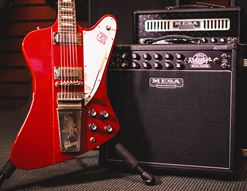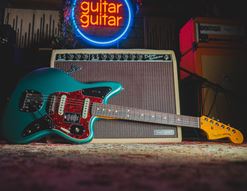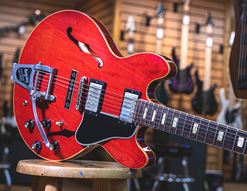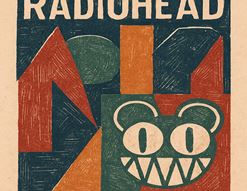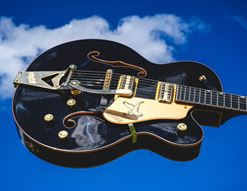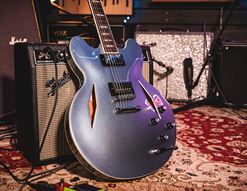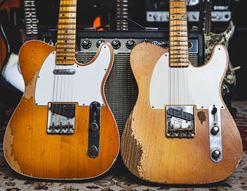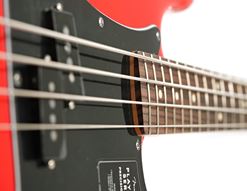Goth music: ironically, given its deathly, funereal aesthetic, it’s one of the most timeless genres in popular music. Its relative popularity comes and goes but in every city in every country in the world, there will be a small and fervent goth scene filled with passionate vampires, lovelorn Byronic poets and Tim Burton-obsessed dark-dwellers.
Well, so goes the cliche anyway, but the standard goth style of black clothes, raven hair, kohl’d eyes and Victorian fashion is steadfastly still the regulation look today.
But where did it all come from? Opinions will differ, and I have an idea about that which I’ll share with you in a second, as I list the best goth bands of all time. But first, here’s a hot take for you…
Goth is Alternative Music
Goth music is actually alternative music. Everything we call ‘alternative rock’ from the Birthday Party to the Cocteau Twins is basically also what goth music is: it’s just dressed differently. The aesthetic of goth culture is pretty clear, but the sound mainly isn’t.
Look at it this way: is Kate Bush goth? Wuthering Heights is about as goth as it gets, with a romance/horror story based on a gothic novel that involves a doomed, deathly love affair. The video has Kate out in an English field dancing extravagantly whilst wearing a long, flowing dress, before vanishing before our eyes like a ghost. Maximum goth, right?
But Kate Bush hardly sounds like Bauhaus, does she? It’s therefore not so much the sound of the music that identifies goth music (although there are plenty of sonic signifiers that lots of goth bands share, such as prominent basslines, low-pitched vocals and danceable rhythms) as the surrounding look and vibe. There’s a particular intention with a lot of goth bands, and that cohesion allows the music itself to be quite disparate in some cases.
Today, I’ll try to cover as much of this vast, windswept space as I can, and hopefully show off the inherent quality and creativity within the confines of what we refer to as ‘goth’.
Now, get another pint of snakebite and check your makeup in the mirror, because you and I are going on a dark and beautiful adventure into the land of goth…
Goth at a Glance
The Doors Were the First Goth Band
The Doors Were the First Goth Band
It’s obvious, isn’t it? The Doors were goth before goth was a thing. Jon Robb makes this point in his book The Art of Darkness and it seems to me that he’s right on the money. Consider the evidence: highly dramatic music? Check. Poetic lyrics about death? Check. Charismatic frontman with a sense of danger and doom about him? Check. Baritone vocals? Check. Even their jauntier tunes have a sense of macabre menace about them, and their darkly beautiful sound has proven hugely popular, if difficult to copy (see my Robby Krieger interview for more on this).
Hell, they even appear on both the soundtrack and the set of The Lost Boys (a pic of Jim resides in the vamps’ lair), which makes them practically goth royalty!
Joy Division
Moving more into the more popularly recognised era of goth music, and Joy Division are the originals of this particular species. Whilst never self-applying the goth term to their music (mainly because it hadn’t been applied to any bands), their sound and overall atmosphere directly inspired a huge raft of bands who immediately followed. Claustrophobic, spacious and game-changingly inventive, Joy Division’s sound was definitely morose but much more besides.
Two albums and a further album’s worth of singles are all we ever got before tragedy occurred, but the small body of work has had a ripple effect like no other.
Siouxsie and the Banshees
Talk about iconic? Siouxsie Sioux is an endlessly inspiring figure whose musical adventurousness can sometimes feel diminished by the ‘goth’ tag, even when she’s one of the most obvious examples of the culture.
Like a few significant 80s artists, Siouxsie (real name Susan Ballion) took inspiration from seeing the Sex Pistols performing live, and began fronting her own bands.
There was always more happening with the Banshees’ music than just guitar, bass and drums, and each successive ‘era’ of the band saw new musical colours emerge alongside the ever-changing lineup. One such era - which brought us the Hyena album - included none other than a certain Robert Smith on guitar duties.
The Cure
To many non-goths, The Cure represents the definitive notion of what goth is all about: a sad man with makeup and bird's nest hair, singing sad songs with lots of effects on his guitar.
On the surface, that’s not too far from the truth, but The Cure have always been a much more multi-faceted band than their genuinely iconic frontman’s image may suggest.
Whether you are an early Pornography era Cure fan or think that Disintegration is their finest moment (I’d say it is), you can hear how vastly different each Cure record can sound.
Bauhaus
When you have a vampire for a lead singer, it's worth leaning into it fully and embracing the goth. That must’ve been how Daniel Ash and his pals felt in Bauhaus, a band who sound both distinctly original and inarguably sinister.
Was it their Northampton origin (in other words, not Laandan) that helped cement their sense of otherness? That, and having a first single as mercurial and mysterious as Bela Lugosi’s Dead, which put down plenty of ‘rules’ for how goth music sounded.
Each member brought something to the table: David J’s basslines were immense, Kevin Haskins’ drums were unpredictable, Daniel Ash’s guitar parts were inventive and Pete Murphy was everybody’s favourite Dark Prince of rock. Well, him or Nick Cave, right?
The Birthday Party
Talking of which, Nick Cave wasn’t always the dignified elder statesmen of gothic songwriting. Back in his pre-Bad Seed days, he was the aggressive, feral and entirely ‘undead’ frontman for twisted Aussie goth-rockers The Birthday Party.
Whose birthday party? I’ve never worked that part out. They get called a ‘post punk’ band, but that means very little in and of itself: all goth bands apart from the Doors are post-punk, after all!
Representing the more confrontational side of goth (a genre not overtly known for its open aggression), the Birthday Party nevertheless evokes the night in many ways, and Rowland S Howard’s pioneering sonic textures were a joy to behold.
It wasn’t to last, of course, but we did then get the Bad Seeds, so let’s not be too sad.
Sisters of Mercy
Effected guitars, a pounding drum machine, a gravelly voice and just the right hat: that was Andrew Eldritch’s recipe for goth success. The Sisters of Mercy are one of those bands you always hear people referring to, but they don’t get played as much these days as in their heyday.
It’s a shame, because there’s at least three classic records in their discography, with Floodlands possibly being the ultimate starting point for newbies. Ultra-influential, they’re like the goth Velvet Underground. Sort of.
Fields of the Nephilim
The Sisters of Mercy didn’t get the monopoly on cool hats, it would seem. These goth rockers from Hertfordshire sang songs about Lovecraft and Crowley (Moonchidl is based on the occultist’s novel) whilst looking like extras from a Fistful of Dollars. An unusual combination, but an evocative one nonetheless.
Vocalist Carl McCoy had a voice that sounded like he’d only just risen from the grave, a sound that obviously endeared them to the goth masses of the mid 80s. The ubiquitous chorus-ey guitar arpeggios and icy synths cemented their sound as one that was none more goth.
After lineup changes and splits, the Nephilim (named after semi-angelic beings from the Old Testament) are currently together and touring.
Dead Can Dance
Almost an entirely different proposition from a standard ‘band’, Dead Can Dance are a group who go all-in: mediaeval instrumentation, exotic rhythmic instruments, and the spectacular sound of twin vocalists Lisa Gerard and Brendan Perry make DCD a band who exist quite in their own atmosphere.
It’s almost incorrect to call them goth, since they are so many other things too, but there’s no doubt that this Aussie/Irish duo are beloved of all night creatures out there.
You’ll recognise Lisa’s voice from movie soundtracks such as Gladiator and Dune, where her incredible (and quite otherworldly) vocals are used for their intense emotional impact.
Dead Can Dance have a body of music well worth diving deeply into, and you can begin by reading our exclusive Dead Can Dance interview.
The Mission
These bands were definitely all shopping at the same place: it’s all about those hats! There is also a similarity in sound, with the danceable beats, ever-chiming guitars and gutter-scraping vocals. It’s a very specific combination of ingredients! The dance element is perhaps less commented on than it should: goths liked the dark side of life for sure, but they also did like a good dance (to show off their outfits and poses as much as anything), and most music that’s considered goth has at least one eye on the dancefloor. That may actually be a key factor to the endurance of the whole culture: it exists for a number of functions, not least as part of a shadowy, dry ice-strewn nightclub. Strike a deathly pose!
Goth-Adjacent Bands
Some bands beloved by goths are not quite able to fit squarely into the goth framework. I call them goth-adjacent, but arguments can be made for their full inclusion, of course…
- Depeche Mode
- Cocteau Twins (and Clan of Xymox and all of label 4AD’s output from Europe, basically)
- Killing Joke
- Evanescence
- Nine Inch Nails
- Type O-Negative
- The Southern Death Cul
The Dead Don’t Die
Goth is alive and well, unfurling its large black wings as it soars off into the night. I do believe that my initial prognosis of goth music being essentially post-punk music holds up, as does the naming of The Doors as the original goth band. What do you think? Would you include bands like Marilyn Manson in the goth vernacular? As with all cultural demarcations, there’s a lot of blurring around the edges of what ‘is’ and what ‘isn’t’. Also, just because bands like The Cure don’t consider themselves goth, doesn’t mean that they aren’t!
Anyway, the main take away here is a timeless aesthetic that always looks great, and a bunch of songs that all sound amazing. What more do you need?
I’ll see you back at the graveyard.

